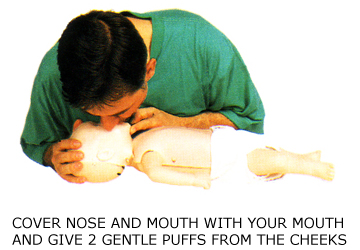Infant Breathing
“B” is for BREATHING (you may skip this section if doing compression-only CPR) 
To artificially respirate an infant, place your mouth over his mouth and nose creating a tight seal and give 2 gentle puffs from your cheeks. Let the victim exhale between breaths – again, watch his chest closely and listen and feel for faint breathing. If the infant victim remains unresponsive (no crying or moving), immediately check his circulation.
1 PERSON CPR CYCLE
Repeat the above sequence counting aloud as you compress 30 times at the rate of 100-120/minute, while minimizing pauses between compressions. Allow full recoil of chest after each compression. Finish the cycle by giving the victim 2 breaths. This cycle should be performed 5 times – 30 compressions followed by 2 breaths – after which the infant’s brachial artery should be checked for pulse and he should be observed for other signs of consciousness. If you do not feel a pulse within 10 seconds, you should begin chest compressions again and continue until AED is available, EMS arrives, or the victim regains consciousness.
2 PERSON CPR CYCLE
Repeat the above sequence by counting aloud as you compress 30 times at the rate of 100-120/minute, while minimizing pauses between compressions. Allow full recoil of chest after each compression; do not lean on the chest after each compression. Finish the cycle by giving the victim 2 breaths. To prevent fatigue and deterioration in quality and rate of chest compressions the rescuers should change compressor and ventilator roles every 2 minutes but the switch should be accomplished as quickly as possible to minimize interruptions in compressions. The victim’s brachial artery should be checked for pulse and he should be observed for other signs of consciousness. If no pulse is detected within 10 seconds, you should begin chest compressions and ventilations again and continue until AED is available, EMS arrives, or the victim regains consciousness.